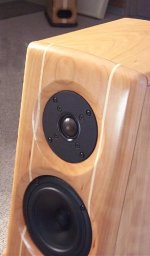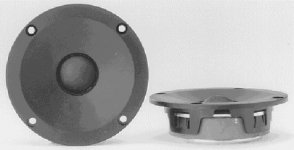The cynical would say it looks like it is doing something
but isn't, and the acousticians would agree with them.
The practical would say its to prevent the drivers from
being damaged if a flat plane is placed against the baffle.
the marketeers woud say ? your guess is as good as mine,
but it seems to look "organic" and allow the sound to "flow".
 sreten.
sreten.
but isn't, and the acousticians would agree with them.
The practical would say its to prevent the drivers from
being damaged if a flat plane is placed against the baffle.
the marketeers woud say ? your guess is as good as mine,
but it seems to look "organic" and allow the sound to "flow".
sreten said:The practical would say its to prevent the drivers from
being damaged if a flat plane is placed against the baffle.
sreten.
Interesting, sreten. I have never thought of that.
But the recess wouldn't hurt, I suppose? So is there any reason why we shouldn't do the same (or any reason we should)?
Vikash said:I wanna say a champfer will have an affect on diffraction...
Are you implying this is a good effect?
It can be a good thing under certain circumstances. I remebered it from this thread.
If I wasn't clear before I will be now, the chamfering has no effect.
(as shown in the original post)
There is no reason to use it (other than damage prevention)
and no particular reason not to use it either, to the degree
shown in the original post.
The speakers shown in the original post appear to have
no provision for protective grilles and I'd suggest QED.
Though I'm sure the marketing department would disagree.
 sreten.
sreten.
(as shown in the original post)
There is no reason to use it (other than damage prevention)
and no particular reason not to use it either, to the degree
shown in the original post.
The speakers shown in the original post appear to have
no provision for protective grilles and I'd suggest QED.
Though I'm sure the marketing department would disagree.
sreten said:If I wasn't clear before I will be now, the chamfering has no effect.
What are you basing this statement on? I would maintain that it at least has a measurable effect, if not an audible one as well.
Russ
WAVEGUIDE
The acoustics of waveguide might be the best mathematics to design and analyze these shallow horns. Waveguides are more common on high efficiency speakers used for large audiences to optimize directionality.
A horn is generally used to increase the acoustic output of a transducer by providing improved loading as compared to directly coupling the transducer to the open environment. Quoting Harry Olsen, "The principal virtue of a horn resides in the possibility of presenting practically any value of acoustical impedance to the sound generator." As a side benefit, it provided some directivity control to the dispersion of acoustical energy. Designers like Bruce Edgar have put greater emphasis on control to the dispersion for home audio horns.
In audio, waveguides are horns with the directional characteristics being the prime design criteria over optimum driver loading.
Acoustic waveguides are sometimes also used to improve dispersion, edge diffraction, and directivity of a transducer like a ribbon that is in a deep rectangular cavity of magnets.
The acoustics of waveguide might be the best mathematics to design and analyze these shallow horns. Waveguides are more common on high efficiency speakers used for large audiences to optimize directionality.
A horn is generally used to increase the acoustic output of a transducer by providing improved loading as compared to directly coupling the transducer to the open environment. Quoting Harry Olsen, "The principal virtue of a horn resides in the possibility of presenting practically any value of acoustical impedance to the sound generator." As a side benefit, it provided some directivity control to the dispersion of acoustical energy. Designers like Bruce Edgar have put greater emphasis on control to the dispersion for home audio horns.
In audio, waveguides are horns with the directional characteristics being the prime design criteria over optimum driver loading.
Acoustic waveguides are sometimes also used to improve dispersion, edge diffraction, and directivity of a transducer like a ribbon that is in a deep rectangular cavity of magnets.
russbryant said:
What are you basing this statement on? I would maintain that it at least has a measurable effect, if not an audible one as well.
Russ
IMO the champhering in the original post will be barely
measurable and next to inaudible compared to flush
mounting the drivers and keeping the formed edges.
(Though the bass unit unit champering may cause wiggles
that could be measured, tonally the speaker won't change)
Its an educated supposition.
I'm with Sreten on this. On the image shown it will make no real diffference. It 's purely for aesthetics.
Similar to how the radius of a rounded baffle edge needs to be large to have any real affect on diffraction, I think a shallow chamfer will have equally little affect on anything.
Lets move on.
Similar to how the radius of a rounded baffle edge needs to be large to have any real affect on diffraction, I think a shallow chamfer will have equally little affect on anything.
Lets move on.
If you look at the "grills" that Meadowlark uses for their speakers it becomes clear why the drivers are inset into the baffle like they are. The grill they use is really just a piece of material with a cord sewn into it the fabric is stretched over the baffle and the cord part fits into the slots between the baffle and speaker. This makes it so the grill is accousticly transparent and there are no soild parts infront of the speakers to cause harmful diffraction.
Hope that helps.
Eric Y
Hope that helps.
Eric Y
Yes, it's done for the aesthetics.
Of course, the real pros go a stage further and hide the fixing screws as well
Of course, the real pros go a stage further and hide the fixing screws as well
An externally hosted image should be here but it was not working when we last tested it.
Eric Y said:If you look at the "grills" that Meadowlark uses for their speakers it becomes clear why the drivers are inset into the baffle like they are. The grill they use is really just a piece of material with a cord sewn into it the fabric is stretched over the baffle and the cord part fits into the slots between the baffle and speaker. This makes it so the grill is accousticly transparent and there are no soild parts infront of the speakers to cause harmful diffraction.
Hope that helps.
Eric Y
Thanks. I may attempt something like this...
I recall a similar waveguide design implemented on some Peerless dome tweeters, called a "wide-angle" faceplate. This is what Peerless has to say:
"A 1" dome tweeter with "wide angle" face plate. A remarkable feature of this 1" dome tweeter is its "controlled directivity". A general problem for tweeters is too much directivity in the high end and unwanted omnidirectionality in the low end. This new concept in dome tweeters has proved to give distinguished musical qualities. We highly recommend this unit for any demanding hi-fi construction."
"A 1" dome tweeter with "wide angle" face plate. A remarkable feature of this 1" dome tweeter is its "controlled directivity". A general problem for tweeters is too much directivity in the high end and unwanted omnidirectionality in the low end. This new concept in dome tweeters has proved to give distinguished musical qualities. We highly recommend this unit for any demanding hi-fi construction."
Attachments
funny...
I'm going to do something similar with a pair of those peerless drivers mentioned above (shielded version).
My main objective is to time align the mid and tweeter, using a cone not to screw up the faceplate response and foam to kill of some of the diffraction.
I'm building a couple of prototypes right now, to measure and see how things turn out. I'm doing stepped circles with foam in between the steps forming the cone (a little hard to descibe, i'll post pictures when i start routing).
I don't have the figures in my head right now, but the cone will be about 25 cm diameter, 1,5 cm deep (not counting the faceplate) keeping the cone about the same angle as the faceplate (~11,5º).
I really don't know if this will be worth the trouble, just doing it out of curiosity. What do you guys think?
What effects do you think this will have on diffraction/horn loading/anything?
I'd really appreciate any ideas you have, as i'm just a newbie myself, these are actually my first speakers ever
regards
/Andreas
I'm going to do something similar with a pair of those peerless drivers mentioned above (shielded version).
My main objective is to time align the mid and tweeter, using a cone not to screw up the faceplate response and foam to kill of some of the diffraction.
I'm building a couple of prototypes right now, to measure and see how things turn out. I'm doing stepped circles with foam in between the steps forming the cone (a little hard to descibe, i'll post pictures when i start routing).
I don't have the figures in my head right now, but the cone will be about 25 cm diameter, 1,5 cm deep (not counting the faceplate) keeping the cone about the same angle as the faceplate (~11,5º).
I really don't know if this will be worth the trouble, just doing it out of curiosity. What do you guys think?
What effects do you think this will have on diffraction/horn loading/anything?
I'd really appreciate any ideas you have, as i'm just a newbie myself, these are actually my first speakers ever

regards
/Andreas
WAVEGUIDE
Though the Meadowlark example cited above is not an effective example of a "waveguide", check the papers by Earl Geddes:
Acoustic Waveguide Theory, JAES vol.37, pp 554-569
Acoustic Waveguide Theory Revisited, JAES vol. 41, pp 452-460
Sound Radiation from Acoustic Apertures, JAES vol. 41, pp 214-230
and by Bauman and Adamson:
Acoustic Waveguides-In Practice JAES vol. 41, pp 462-470
Though the Meadowlark example cited above is not an effective example of a "waveguide", check the papers by Earl Geddes:
Acoustic Waveguide Theory, JAES vol.37, pp 554-569
Acoustic Waveguide Theory Revisited, JAES vol. 41, pp 452-460
Sound Radiation from Acoustic Apertures, JAES vol. 41, pp 214-230
and by Bauman and Adamson:
Acoustic Waveguides-In Practice JAES vol. 41, pp 462-470
The tweeter would most likley have been put back into the baffle to delay its output to bring it inline timewise with the woofer. The finishing of the edge would result in a change in both measured and perceived response. Wether or not any of this is worth the trouble is up to the designer. If it sounds better, do it. If you can't hear the difference, go with the pretty option. If your woodworking is lame, go with the easy option.
From my experience time delays and edge shapes around tweeters are very noticeable.
From my experience time delays and edge shapes around tweeters are very noticeable.
- Status
- This old topic is closed. If you want to reopen this topic, contact a moderator using the "Report Post" button.
- Home
- Loudspeakers
- Multi-Way
- Baffle Construction Techniques

